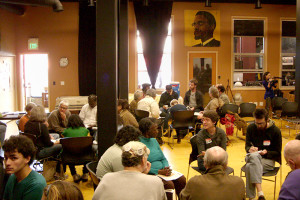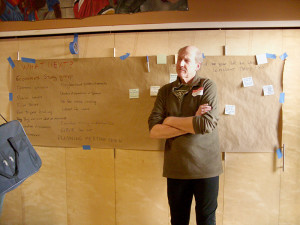Oakland Residents Meet to Find Debt Solutions

Nearly a hundred Oakland residents met at the Eastside Arts Alliance in Oakland last Saturday to ignite a community effort to minimize the role of debt in society.
Statistics from the Federal Reserve show that personal debt has risen from $1,186 per person in 1948 to $10,168 in 2010. This number includes credit card debt, student loans, and car loans.
Since 1980, credit card debt alone has risen by 285 percent, to $3,480 per capita. Bankruptcy filings have increased from 110,000 in 1960, to 1.6 million in 2003, according to the Department of Justice.
“A lot of us are actually drowning in debt for the most basic things we need to live,” said Hannah Appel, one of the organizers of the event. “Not because we bought a car on credit, not because we want fancy things for our homes, but for our house, for our education and for our health care.”
Even individuals who don’t have any debt, Appel said, are affected by this problem. Debt at a state, national, and city level affect ordinary peoples’ lives through underfunding of schools and roads that are damaged and need to be fixed.
It was an intimate meeting; many of the speakers declined to have their full names disclosed and spoke solely on a first name basis. Members of the audience were invited to share their secrets of debt in private groups, and to help each other come up with solutions, both personal and social, to solve their crisis.

the event.
The East Bay Community Law Center, Debtors Anonymous, the Occupy Oakland Foreclosure Defense Group, the Alliance of Californians for Community Empowerment and CORE magazine all showed support for the event, passing out flyers to the attendees and offering help with their debt, including inviting members of the audience to debt clinics, where people can receive help and find solutions for paying off their loans.
Healthcare is the number one cause of bankruptcy, according to Appel, and families that are financially stable can suddenly find themselves deep in debt once their medical bills come in after a sudden accident.
Claire Haas, of Alliance of Californians for Community Empowerment, explained to the audience that 25 percent of foreclosures nationwide happen in California; 35 percent of all mortgages are underwater, meaning that the amount owed is more than the home’s market value.
“One of the stats that’s out there, says that if banks were to reduce the principal on homes so that homeowners aren’t underwater, it would create a million jobs across the country because of how that reinvests in the economy,” explained Haas.
Costs nationwide have gone up due to the consolidation of the banking industry, while wages have fallen. Since 1990, all of the banks in the country have merged with or been bought by four of the existing “big banks” today: Citibank, Bank of America, JP Morgan Chase, and Wells Fargo, she further explained.
Cities or organizations who were victims of the LIBOR scandal, in which top international bankers in London admitted to fixing interest rates to secure higher profits, could receive damages from that organization if they sue, said Haas. There were $8 trillion in damages, and due to the nature of the lawsuit LIBOR can be sued for up to $24 trillion, she said.
Haas implored members of the audience to contact their city council members and ask them to investigate if they were eligible to receive damages from the banks.
One way cities can be pulled into predatory deals on loans is through the use of an interest swap, she said. Before the recession Oakland was given an interest swap, which led to the city paying more on its debt, she said.
Despite having paid off its loans, Oakland still has to pay $4 million a year on overpayments, she said.
However, the Oakland City Council has recently decided to stop Goldman Sachs from doing business with any of the city’s businesses, and said that if they won’t let them out of the deal at no cost, they will stop making payments.
The Asian Art Museum had a similar interest swap that almost drove them to default on their debt. They were able to negotiate their way out of the deal, she said, and they made some money back because of it.
Margaret Rossoff stepped in to moderate a group discussion on the audience’s thoughts concerning finding both large scale and small scale solutions to debt.
Civil disobedience, teaching financial literacy and focusing on pressuring local representatives to pass legislation to fight banks who give out predatory loans, were some of the main ideas.
There were also ideas to end private banking, mint a trillion dollar coin like the one economist Paul Krugman endorsed last month, and to allow people with student debt to file for bankruptcy on their loans.
Rossoff also spoke about the need for direct involvement from students and had a suggestion for how students could start getting involved.
“I think the students should organize student debtors unions, and work together on solutions,” proposed Rossoff. “I think getting together around that would be really good.”
The proposed solutions all pointed to the underlying objective of the day.
“Changing the whole structure of debt,” said Rossoff. “I think there’s so many kinds of actions, whether they’re direct actions and civil disobedience, whether they’re legislative actions to try to change some of the laws, whether they’re individual actions to see a lawyer together, help everyone’s situation.”














